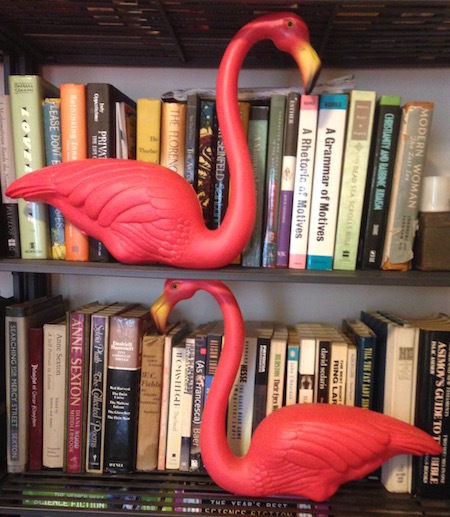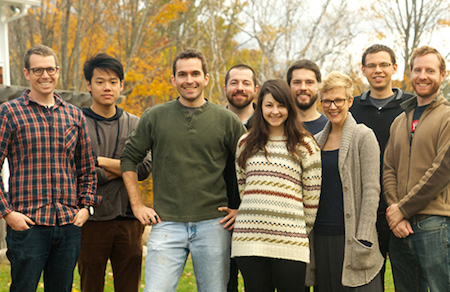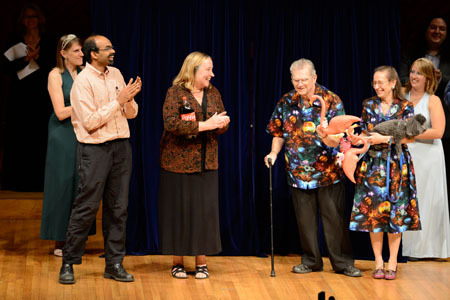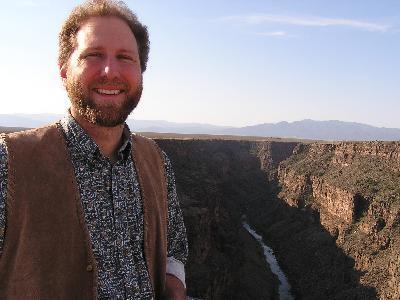Marc Abrahams's Blog, page 322
June 25, 2015
Books to train your brain to suchandsuch or thisandthat
If you want to buy a book to try to train your brain to do something, you have many somethings and many books to choose from. Here’s a sampling:
Train Your Brain to be a Genius , by John Woodward, 2009.
Train Your Brain to Get Thin: Prime Your Gray Cells for Weight Loss, Wellness, and Exercise , by Melinda Boyd and Michele Noonan.
Train Your Brain to Get Happy: The Simple Program That Primes Your Grey Cells for Joy, Optimism, and Serenity , by Aubele PhD, Teresa, Wenck, Stan and Susan Reynolds, 2011.
Train Your Brain to Get Rich: The Simple Program That Primes Your Gray Cells for Wealth, Prosperity, and Financial Security , by Teresa Aubele PhD, Doug Freeman JD LLM, Lee Hausner PhD, Susan Reynolds, 2011.
There is a near-infinity of other such books available for consideration by you or your brain. All of them may be equally effective.
Near-infinity extends in many (perhaps a near-infinity of) directions. In one direction, you can find the splendid Brain Train, invented by Ig Nobel Prize winner Bart Knols. In a very different direction, you can find BrainTrain.

June 24, 2015
Podcast #17: The real-life Wizard of Oz
The real-life Wizard of Oz, artificial fruit processing in children and chimps, and other things, turn up in this week’s Improbable Research podcast.
Click on the “Venetian blinds” icon — at the lower right corner here — to select whichever week’s episode you want to hear:
SUBSCRIBE on Play.it or iTunes, to get a new episode every week, free.
[NEWS: Soon, the podcast will also be available on Spotify.]
This week, Marc Abrahams tells about:
The real-life Wizard of Oz. (Dr. Nakamats / Dr. Nakamats’s upcoming Final Birthday Party / Swedish interview with Dr. Nakamats about his patent for a self-defense wig / Dr. Nakamats medical news announcement. Featuring dramatic readings by Robin Abrahams (@RobinAbrahams), who writes the Miss Conduct advice column in the Boston Globe. Here’s a teaser from the documentary “The Invention of Dr. Nakamats“:
Artificial fruit processing in children and chimpanzees (“Imitative learning of artificial fruit processing in children (Homo sapiens) and chimpanzees (Pan troglodytes),” A. Whiten, D.M. Custance, J.C. Gomez, P. Teixidor P, and K.A. Bard, Journal of Comparative Psychology, vol. 110, no. 1, March 1996, pp. 3-14. Featuring dramatic readings byby Nicole Sharp (@fyfluiddynamics), who created and produces FYFD.)
Soft Is Hard. (“The Physical Burdens of Secrecy,” M.L. Slepian, E.J. Masicampo, N.R. Toosi, and N. Ambady, Journal of Experimental Psychology: General, vol. 141, 2012, pp. 619–24. / “Big Secrets Do Not Necessarily Cause Hills to Appear Steeper,” Etienne P. LeBel and Christopher J. Wilbur, Psychonomic Bulletin and Review, 21(3), 2014, 696-700. / “Passing Encounters: Patterns of Recognition and Avoidance in Pedestrians,” Miles L. Patterson, A. Webb, and W. Schwartz, Basic and Applied Social Psychology, vol. 24, 2002, pp. 57–66. / “Through a Glass Darkly: Effects of Smiling and Visibility on Recognition and Avoidance in Passing Encounters,” Miles L. Patterson and Mark E. Tubbs, Western Journal of Communication, vol. 69, no. 3, July 2005, pp. 219–31. Featuring dramatic readings by Bill Hoston, who teaches physics and drinks coffee.)
What you can do with a cat, a cow, and a bag. (Ely, Fordyce, and W. E. Petersen (1941). ‘Factors Involved in the Ejection of Milk.’ Journal of Dairy Science 3: 211–23. / May, D. N. (1971). ‘Startle in the Presence of Background Noise.’ Journal of Sound and Vibration 17 (1): 77–78. / Lukas, Jerome. S. (1972). ‘Awakening Effects of Simulated Sonic Booms and Aircraft Noise on Men and Women.’ Journal of Sound and Vibration 20 (4): 457–66. / Rylander, R., S. Sörensen, and K. Berglund (1972). ‘Sonic Boom Effects on Sleep: A Field Experiment on Military and Civilian Populations.’ Journal of Sound and Vibration 24 (1): 41–50. Featuring dramatic readings by Maggie Lettvin, who created and is “The Beautiful Machine“.)
The Swan Song of Dr. Nakamats. (Swedish public television broadcast of Dr. Nakamats performing the song in Stockholm, the day after the train ride you hear in the podcast.)
The mysterious John Schedler perhaps did the sound engineering this week.
The Improbable Research podcast is all about research that makes people LAUGH, then THINK — real research, about anything and everything, from everywhere —research that may be good or bad, important or trivial, valuable or worthless. CBS distributes it, both on the new CBS Play.it web site, and on iTunes (and soon, also on Spotify).

Advice to kids: Just say no (to fainting)
Mass inoculation programs for school children sometimes encounter problems – with considerable numbers of children fainting. Fortunately, in 1973, a very straightforward remedial strategy was discovered by Alan Hedberg and Audrey Schlong. It was described in the journal Nursing Research.

June 23, 2015
The final birthday party of Dr. Nakamats, this Friday in Tokyo
I am traveling to Tokyo to take part in the final birthday party — that’s how he describes it — of Dr. Nakamats, the world’s most inventive inventor (more than 3500 patents, including patents for the floppy disk, the self-defense wig, and flying shoes), author, political candidate, Ig Nobel Prize winner (in 2005, for having photographed every meal he had consumed during the previous 34 years) and the closest we will ever see to a real-life Wizard of Oz.
Unlike most people’s birthday parties, this one will happen at the National Press Club, in Tokyo. Dr. Nakamats was diagnosed with a form of prostate cancer that will kill him, his doctors say, some time before the end of this year. Dr. Nakamats, in characteristic form, is choosing to make the very best of the situation.
There will be nine days of Nakamats and Ig Nobel events — the first-ever official Ig Nobel Prize events to be held in Japan. Several other of Japan’s many Ig Nobel Prize winners will participate in some of those events.
If, somehow, you have never encountered the wonder that is Dr. Nakamats, you can get a good introduction by watching Danish filmmaker Kaspar Astrup Schröder’s mesmerizing documentary called “The Invention of Dr. Nakamats.” Schröder is filming a second documentary, which will include footage from some of the upcoming events.
Here is the schedule of events (we will frequently update the details, on our events listing page — so check there to see the latest version of this list):
June 26, Friday: Sir Dr. NakaMats 87 the LAST birthday party & Ig Nobel Prizes Japan Event Press Conference, @Japan National Press Club, 10th floor Nippon Press Center Bldg., 2-2-1 Uchisaiwaicho, Chiyoda-ku, Tokyo Tel:03-3503-2721
June 27 (Saturday) 12:00-12:30 Sir Dr. NakaMats Cancer CD Artist Debut Event @GINZA
June 28 (Sunday) 13:30- Lecture at Tokyo City University and Setagaya-ku.
June 30 (Tuesday) Ig Nobel event at University of Tokyo – public lecture in science — featuring Dr. Nakamats and other Ig Nobel prize winners: Toshiyushi Nakagaki (slime molds can solve puzzles), Masanori Niimi (effect of opera songs on heart transplant patients who are mice), Yukio Hirose (why one particular bronze statue fails to attract pigeons), Shinsuki Imai (biochemistry of onions causing human tears), and others. Details TBA.
July 1 (Wednesday) 15:00-16:00. Ig Nobel Event at Foreign Correspondents’ Club of Japan. Details TBA.
July 3 (Friday) Ig Nobel Event at Chuo-prefecture. Details TBA.
July 4 (Saturday) 10:00. Marc Abrahams will cut the tape at the Opening ceremony of the World Genius Convention, of which Sir Dr. NakaMats is chairman.
Other events, possibly in profusion, TBA
If you are in Tokyo, please join us at one or more of these events. If you have friends in Tokyo, please spread the word.
Here is a further look at the world of Dr. Nakamats:

Be still my beating heart … smashed fingers, battered shins and fake murder
If you (yup, you) use a fake weapon to brutally beat a stranger, and then slit his throat, and then shoot him in the face, and then you assault a little baby, will your heart and blood pump like mad — even if you know that it’s all a trick and the man will suffer no harm and the baby is just a life-like doll? An American experiment sought an answer to that question.
You can read about it in a study called Simulating Murder: the Aversion to Harmful Action, published in the journal Emotion. The authors, Fiery Cushman [pictured below, with colleagues from his lab], Kurt Gray, Allison Gaffey and Wendy Berry Mendes, are respectively at Harvard University, the University of Maryland, the University of Notre Dame, and the University of California, San Francisco.…
So begins this month’s Improbable Research column in The Guardian.

June 22, 2015
Sad news: Don Featherstone, creator of the plastic pink flamingo, died today
Don Featherstone, the creator of the plastic pink flamingo, died this morning. He was a friend, whom we have known since 1996, the year he was awarded the Ig Nobel Prize for art.

Don and his wife, Nancy Featherstone, came to almost every Ig Nobel Prize ceremony in succeeding years, where adoring throngs cheered them and the plastic pink flamingos. He has been ill the past few years. This photo shows Don and Nancy (who, every day of their marriage, wore matching outfits designed by Nancy) at one of their last Ig Nobel appearances, in 2012:
Don created the flamingo when he was freshly graduated from art school, and newly employed at a plastics factory. One of his first assignments was to create three-dimensional plastic lawn ornaments (up to that time, most plastic lawn ornaments were more or less flat). The flamingo was one of his earliest efforts for the factory.
Eventually he became president of the company. After Don retired, dire things were done, by his successor, to the flamingo, triggering a worldwide protest, which eventually led to a more or less happy rallying of the forces of Good, and a restoration of the plastic pink flamingo’s status. In 2011, the flamingo attained new heights, when the Disney movie Gnomeo and Juliet featured a plastic pink lawn ornament named “Featherstone”. Don and Nancy were feted at the film’s premiere.
The flamingos inspired the film that launched John Waters‘s directorial career: Pink Flamingos. The flamingos also inspired the birth of several businesses that supply flamingoes en mass, as surprise visitors to the lawn of a beloved or despised neighbor. One of those businesses produced this tribute/promotional video, in 2008:
Don Featherstone was a happy, kind, and thoughtfully imaginative man, who became famous for his goofiest, tackiest creation. It was “goofiest” and “tackiest” by Don’s own reckoning — he was a richly talented artist, but felt that, given the fame and financial security the flamingo brought him, he ought to publicly act as if he were interested only in making happy goofy, plastic art. In 2012, Abigail Tucker wrote a history of the flamingo’s effect on the world, in Smithsonian magazine, with the headline “The Tacky History of the Pink Flamingo.”
Please think of Don, and raise a smile, whenever you see a flamingo, be it plastic or of some less physically durable species.
(The photo above shows two of the flamingos Don donated to the Improbable Research museum.)
UPDATE: Reader Scott Valla suggests: “Everyone please stand in your yard on one leg for a moment of silence.”

The role of flapping elephant ears in heat dissipation
Elephants are big, and they get hot. Especially in Africa. Thus, from the elephant’s point of view, there’s sometimes an urgent necessity to dissipate excess heat.
Some investigators have suggested that flapping their large ears (strictly, their ‘pinnae’) could provide a significant heat-loss mechanism. (e.g. Buss, I. O., and Estes, J. A., 1971, ‘The Functional Significance of Movements and Positions of the Pinnae of the African Elephant. Loxodonta Africana‘, Journal of .Mammalogy, 52, pp. 21-27) But, until 2013, no formal studies had investigated the transient effects of the flapping motion on the elephant pinna’s surface temperature. Prompting Dr. Moise Koffi (of the Department of Academic Affairs, CUNY-Hostos Community College, Bronx, NY, US) along with Prof. Yiannis Andreopoulos and Prof. Latif M. Jiji (both of the Department of Mechanical Engineering, The City College of New York, NY, US) to perform a series of controlled laboratory-based studies. Their experiments included the use of full-sized flapping leather faux elephant ears, silicone heaters, and a smoke machine – along with computer-model thermal simulation techniques.
The results of the experiments and simulations not only demonstrated and quantified the efficacy of ear flapping, but also showed (for the first time) the role played by swirling air vortices [see photo below].
[…] our results agree with the conclusion reached by previous researchers that the flapping of the pinna should be the main thermoregulatory mechanism of the body temperature of large animals such as African elephants. The present contribution, however in the context of the current understanding, is in identifying the vortical system that is responsible for the heat transfer enhancement
observed in the present work which is further amplified in the case of flexible surface.”
See: The Role of Pinnae Flapping Motion on Elephant Metabolic Heat Dissipation in: The Journal of Heat Transfer, Volume 136, Issue 10.
The $14.95 question : In the light of the new findings, are questions (and answers) like these in need of revision? [thanks to P.H. for the link]
BONUS: The famous Disney cartoon version of elephant ear flapping:

June 21, 2015
Ig Nobel ceremony tickets will go on sale July 9
Tickets for the 25th First Annual Ig Nobel Prize ceremony will go on sale on THURSDAY, JULY 9, 2015 at NOON (Boston time). They will be available exclusively from the Harvard Box Office (online, by phone, and at Holyoke Center).
If you want us to notify you the day before they go on sale, add yourself to the Improbable events notification private email list.
The ceremony itself will happen on Thursday evening, September 17, at Sanders Theatre, Harvard University, Cambridge, Massachusetts, USA, Planet Earth, Milky Way, etc.
Here’s the ceremony poster (click on the image to see a hi-res version that you can download):

Praga-dialectics update: An analysis of “Yes, but …”
 The ArgLab at the Faculty of Social Sciences and Humanities, Universidade Nova de Lisboa, Portugal, is concerned with argumentation and decision making processes as far as they can be philosophically approached and thus related with Practical Reason and Values. For a representative recent publication from the lab, see: ‘Managing disagreement through yes, but… constructions: An argumentative analysis’ (by Mehmet Ali Uzelgun, Dima Mohammed, Marcin Lewiński, and Paula Castro, in: Discourse Studies April 28, 2015)
The ArgLab at the Faculty of Social Sciences and Humanities, Universidade Nova de Lisboa, Portugal, is concerned with argumentation and decision making processes as far as they can be philosophically approached and thus related with Practical Reason and Values. For a representative recent publication from the lab, see: ‘Managing disagreement through yes, but… constructions: An argumentative analysis’ (by Mehmet Ali Uzelgun, Dima Mohammed, Marcin Lewiński, and Paula Castro, in: Discourse Studies April 28, 2015)
“The goal of this study is to examine the argumentative functions of concessive yes, but… constructions. Based on (N = 22) interview transcripts, we examine the ways environmental activists negotiate their agreements and disagreements over climate change through yes, but… constructions. Starting from conversational analyses of such concessive sequences, we develop an account grounded in argumentative discourse analysis, notably pragma-dialectics. ”
Bonus argumentative resource: The Journal of Argumentation in Context.
Also see: (Improbable posts)
“YES!” – a comprehensive review (part 1)
“YES!” – a comprehensive review (part 2)

June 20, 2015
An insipid CH star in the Sculptor dwarf spheroidal galaxy
An insipid CH star in the Sculptor dwarf spheroidal galaxy is the subject of this study:
“An insipid CH star in the Sculptor dwarf spheroidal galaxy,” Matthew D. Shetrone [pictured here], Michael Briley, and James P. Brewer, Astronomy and Astrophysics, 335 (1998): 919-921.

Marc Abrahams's Blog
- Marc Abrahams's profile
- 14 followers








